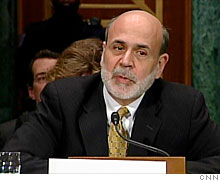Search News
(Fortune) -- Will the Federal Reserve ever get a chance to hang up its financial firefighting hat?
Ever since the markets started melting down almost three years ago, Federal Reserve chairman Ben Bernanke has been splashing cash on new outbreaks. The latest episode came when the Fed agreed this week to provide foreign central banks with dollars to ease the latest funding crisis among European banks.
 |
| Ben Bernanke's back in the business of lending dollars to banks in Europe. |
Until this week, Bernanke had been counting the expiration of several special Fed lending programs -- including an earlier version of the central bank swap lines -- as a sign that one part of the Fed's mission was accomplished. Bernanke has said he wants to return the Fed to its pre-crisis state and has sketched out a so-called exit strategy for accomplishing that.
But after more than two years of massive monetary support, the world economy is still awash in debt and vulnerable to withdrawal symptoms -- which is complicating the Fed's plan to pull back.
"That solvency concerns related to relatively small governments in the euro area should force a U-turn in the Fed's exit strategy shows just how interconnected global markets are," said Tullett Prebon economist Lena Komileva.
Over the past month, the crisis in the heavily indebted Southern European states of Greece and Portugal started to put pressure on European banks, which hold huge amounts of euro-denominated debt as well as large sums of dollar assets.
Worries about the risks of a Greek default made the banks' trading partners nervous about whether they would get their money back -- an echo of the post-Lehman Brothers meltdown of 2008.
This sent the banks' funding costs higher, and threatened to raise borrowing costs everywhere at a time when policymakers are trying to keep funds flowing into slowly recovering economies.
In response, European officials agreed to create a bailout fund, and the Fed extended the swap lines to make sure European banks can get dollars.
The Fed had as much as $580 billion on loan at the height of the crisis in 2008, according to the New York Fed. It hasn't said how big its loans to other central banks might be this time, though few expect a figure that large. The Fed stresses that it doesn't take any credit risk in the swaps.
"More liquidity is the solution to everything right now," said Matthew Lloyd, chief investment strategist at Advisors Asset Management. "They're trying to buy time, but the fundamental problems aren't going anywhere."
Indeed, austerity is the watchword in places like Greece, where the government has promised sharp cutbacks. Even in the U.S., where the economic recovery has been stronger than in Europe, growth is expected to slow in the second half amid rising taxes, falling stimulus spending and the recent rise in the value of the dollar against the euro.
This means the Fed's efforts to extricate itself from all its emergency spending over the past two years will necessarily be deliberate, though the Fed continues to lay the groundwork for its exit.
On Monday, the Fed said it would run five small tests of a plan to offer U.S. banks the equivalent of certificates of deposit. The so-called term deposits are one in a series of programs that Bernanke has said would allow the Fed to drain "hundreds of billions of dollars of reserves from the banking system quite quickly, should it choose to do so."
Banks are sitting on $1 trillion of excess reserves, thanks to the Fed's unusual lending programs. Investors fear that those reserves could feed inflation if they are still sitting in the banking system when economic growth kicks in -- though few expect that for at least another year.
In the meantime, there may well be more fires to fight.
"The Fed wants to be on a level glide path as we go into the second half of 2010," said Matt Freund, a portfolio manager at USAA. "They want to be able to accelerate or hit the brakes depending on what they see." ![]()






| Company | Price | Change | % Change |
|---|---|---|---|
| Ford Motor Co | 8.29 | 0.05 | 0.61% |
| Advanced Micro Devic... | 54.59 | 0.70 | 1.30% |
| Cisco Systems Inc | 47.49 | -2.44 | -4.89% |
| General Electric Co | 13.00 | -0.16 | -1.22% |
| Kraft Heinz Co | 27.84 | -2.20 | -7.32% |
| Index | Last | Change | % Change |
|---|---|---|---|
| Dow | 32,627.97 | -234.33 | -0.71% |
| Nasdaq | 13,215.24 | 99.07 | 0.76% |
| S&P 500 | 3,913.10 | -2.36 | -0.06% |
| Treasuries | 1.73 | 0.00 | 0.12% |
|
Bankrupt toy retailer tells bankruptcy court it is looking at possibly reviving the Toys 'R' Us and Babies 'R' Us brands. More |
Land O'Lakes CEO Beth Ford charts her career path, from her first job to becoming the first openly gay CEO at a Fortune 500 company in an interview with CNN's Boss Files. More |
Honda and General Motors are creating a new generation of fully autonomous vehicles. More |
In 1998, Ntsiki Biyela won a scholarship to study wine making. Now she's about to launch her own brand. More |
Whether you hedge inflation or look for a return that outpaces inflation, here's how to prepare. More |